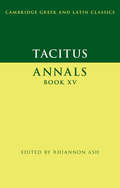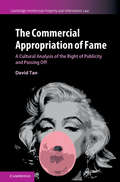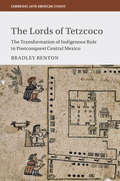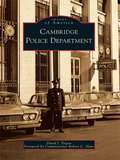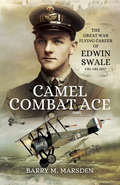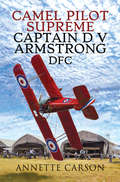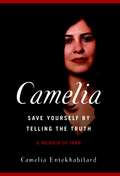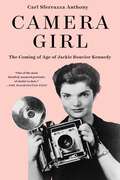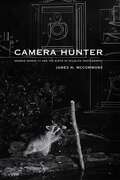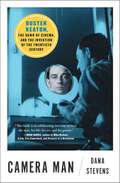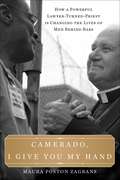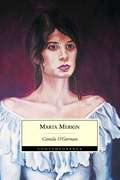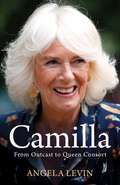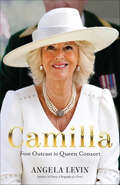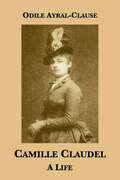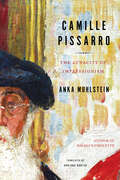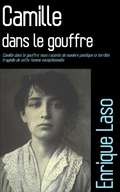- Table View
- List View
Cambridge Classical Studies: M. I. Finley
by Michael Scott Robin Osborne Daniel JewM. I. Finley (1912-86) was the most famous ancient historian of his generation. He was admired by his peers, and was Professor of Ancient History at the University of Cambridge and Fellow of the British Academy. His unmistakable voice was familiar to tens of thousands of radio listeners, his polemical reviews and other journalism were found all over the broadsheets and weeklies, and his scholarly as well as his popular works sold in very large numbers as Penguin paperbacks. Yet this was also a man dismissed from his job at Rutgers University when he refused to answer the question of whether he was or had ever been a member of the Communist Party. This pioneering volume assesses Finley's achievements and analyses the nature of the impact of this charismatic individual and the means by which he changed the world of ancient history.
Cambridge Companions to American Studies: The Cambridge Companion to John F. Kennedy
by Andrew HoberekJohn F. Kennedy remains central to both the American and the global imagination. Featuring essays by leading literary critics, historians, and film scholars, The Cambridge Companion to John F. Kennedy addresses such topics as Kennedy's youth in Boston and his time at Harvard, his foreign policy and his role in reshaping the US welfare state, his relationship to the civil rights and conservative movements, and the ongoing reverberations of his life and death in literature and film. Going beyond historical or biographical studies, these chapters explore the creation and afterlife of an icon, a figure who still embodies - and sparks debate about - what it means to be American.
Cambridge Greek and Latin Classics: Tacitus
by Rhiannon AshThe Histories is the first historical work by Rome's most accomplished and challenging historian, Tacitus. It narrates the brutal civil wars which broke out in AD 68-9 across the Roman Empire after the suicide of the last Julio-Claudian emperor, Nero. Book II covers the bloody finale of the war between two of those emperors, Otho and Vitellius, and the emerging challenge from the eventual victor, Vespasian. The progression of events, kaleidoscopic and gripping, unfolds over a broad geographical sweep and is presented by Tacitus with consummate artistry. This commentary on Histories Book II elucidates historical questions, clarifies Tacitus' historiographical techniques and explains grammatical difficulties of the Latin for students. It also includes a Latin text, relevant maps, and a comprehensive introduction discussing historical, literary and stylistic questions.
Cambridge Historical Studies in American Law and Society: Before Dred Scott
by Anne TwittyBefore Dred Scott draws on the freedom suits filed in the St Louis Circuit Court to construct a groundbreaking history of slavery and legal culture within the American Confluence, a vast region where the Ohio, Mississippi, and Missouri Rivers converge. Formally divided between slave and free territories and states, the American Confluence was nevertheless a site where the borders between slavery and freedom, like the borders within the region itself, were fluid. Such ambiguity produced a radical indeterminacy of status, which, in turn, gave rise to a distinctive legal culture made manifest by the prosecution of hundreds of freedom suits, including the case that ultimately culminated in the landmark United States Supreme Court decision in Dred Scott vs Sandford. Challenging dominant trends in legal history, Before Dred Scott argues that this distinctive legal culture, above all, was defined by ordinary people's remarkable understanding of and appreciation for formal law.
Cambridge Intellectual Property and Information Law: The Commercial Appropriation of Fame
by David TanCelebrities can sell anything from cars to clothing, and we are constantly fascinated by their influence over our lifestyle choices. This book makes an important contribution to legal scholarship about the laws governing the commercial appropriation of fame. Exploring the right of publicity in the US and the passing off action in the UK and Australia, David Tan demonstrates how an appreciation of the production, circulation and consumption of fame can be incorporated into a pragmatic framework to further the understanding of the laws protecting the commercial value of the celebrity personality. Using contemporary examples such as social media and appropriation art, Tan shows how present challenges for the law may be addressed using this cultural framework. This book will be of interest to intellectual property law academics, judges, practitioners and students in the US and common law jurisdictions, as well as those in the field of cultural studies.
Cambridge Latin American Studies: The Transformation of Indigenous Rule in Postconquest Central Mexico (Cambridge Latin American Studies #104)
by Bradley BentonTetzcoco was one of the most important cities of the pre-Hispanic Aztec Empire. When the Spaniards arrived in 1519, the indigenous hereditary nobles that governed Tetzcoco faced both opportunities and challenges, and were forced to adapt from the very moment of contact. This book examines how the city's nobility navigated this tumultuous period of conquest and colonialism, and negotiated a place for themselves under Spanish rule. While Tetzcoco's native nobles experienced a remarkable degree of continuity with the pre-contact period, especially in the first few decades after conquest, various forces and issues, such as changing access to economic resources, interethnic marriage, and intra-familial conflict, transformed Tetzcoco's ruling family into colonial subjects by the century's end.
Cambridge Police Department (Images of America)
by David J. Degou Commissioner Robert HaasFormally organized in 1859 with the appointment of John C. Willey as the first chief of police, the Cambridge Police Department was then manned by only 16 officers. The department has grown dramatically from its humble beginnings and today employs 277 sworn officers and a civilian staff of 37. Cambridge Police Department, the first comprehensive photographic history of the department, contains over 100 years of historical photographs, including images of specialized traffic and K-9 units, auxiliary police officers, uniforms, and equipment. Many of the vintage photographs in the collection have come from the department archives or were donated by family members of Cambridge officers.
Cambridge Scientific Minds
by Simon Mitton Peter HarmanSince the 'scientific revolution' of the seventeenth century, a great number of distinguished scientists and mathematicians have been associated with the University of Cambridge. Cambridge Scientific Minds provides a portrait of some of the most eminent scientists associated with the University over the past 400 years, including accounts of the work of three of the greatest figures in the entire history of science, Isaac Newton, Charles Darwin and James Clerk Maxwell. The chronological balance reflects the increasing importance of science in the recent history of the University. The book comprises personal memoirs and historical essays, including contributions by leading Cambridge scientists. Cambridge Scientific Minds will be of interest not only to graduates of the University, science students and historians of science, but to anyone wishing to gain an insight into some of the greatest scientific minds in history.
Cambridge Studies in Early Modern British History: The Political Bible in Early Modern England
by Kevin KilleenThis illuminating new study considers the Bible as a political document in seventeenth-century England, revealing how the religious text provided a key language of political debate and played a critical role in shaping early modern political thinking. Kevin Killeen demonstrates how biblical kings were as important in the era's political thought as any classical model. The book mines the rich and neglected resources of early modern quasi-scriptural writings - treatise, sermon, commentary, annotation, poetry and political tract - to show how deeply embedded this political vocabulary remained, across the century, from top to bottom and across all religious positions. It shows how constitutional thought, in this most tumultuous era of civil war, regicide and republic, was forged on the Bible, and how writers ranging from King James, Joseph Hall or John Milton to Robert Filmer and Thomas Hobbes can be better understood in the context of such vigorous biblical discourse.
Cambridge Studies in Nineteenth-Century Literature and Culture: Writing Arctic Disaster
by Adriana CraciunHow did the Victorian fixation on the disastrous John Franklin expedition transform our understanding of the Northwest Passage and the Arctic? Today we still tend to see the Arctic and the Northwest Passage through nineteenth-century perspectives, which focused on the discoveries of individual explorers, their illustrated books, visual culture, imperial ambitions, and high-profile disasters. However, the farther back one looks, the more striking the differences appear in how Arctic exploration was envisioned. Writing Arctic Disaster uncovers a wide range of exploration cultures: from the manuscripts of secretive corporations like the Hudson's Bay Company, to the nationalist Admiralty and its innovative illustrated books, to the searches for and exhibits of disaster relics in the Victorian era. This innovative study reveals the dangerous afterlife of this Victorian conflation of exploration and disaster, in the geopolitical significance accruing around the 2014 discovery of Franklin's ship Erebus in the Northwest Passage.
Cambridge Studies in Opera: Technology and the Diva
by Karen HensonIn Technology and the Diva, Karen Henson brings together an interdisciplinary group of scholars to explore the neglected subject of opera and technology. Their essays focus on the operatic soprano and her relationships with technology from the heyday of Romanticism in the 1820s and 1830s to the twenty-first-century digital age. The authors pay particular attention to the soprano in her larger than life form, as the 'diva', and they consider how her voice and allure have been created by technologies and media including stagecraft and theatrical lighting, journalism, the telephone, sound recording, and visual media from the painted portrait to the high definition simulcast. In doing so, the authors experiment with new approaches to the female singer, to opera in the modern - and post-modern - eras, and to the often controversial subject of opera's involvement with technology and technological innovation.
Came Men on Horses: The Conquistador Expeditions of Francisco Vásquez De Coronado and Don Juan De Onate
by Stan HoigGuided by myths of golden cities and worldly rewards, policy makers, conquistador leaders, and expeditionary aspirants alike came to the new world in the sixteenth century and left it a changed land. Came Men on Horses follows two conquistadors--Francisco Vázquez de Coronado and Don Juan de Oñate--on their journey across the southwest. Driven by their search for gold and silver, both Coronado and Oñate committed atrocious acts of violence against the Native Americans, and fell out of favor with the Spanish monarchy. Examining the legacy of these two conquistadors Hoig attempts to balance their brutal acts and selfish motivations with the historical significance and personal sacrifice of their expeditions. Rich human details and superb story-telling make Came Men on Horses a captivating narrative scholars and general readers alike will appreciate.
Camel Combat Ace: The Great War Flying Career of Edwin Swale CBE OBE DFC*
by Barry M. MarsdenA thrilling account of a World War I airman&’s service in the skies over the trenches: &“Well detailed and illustrated. . . . highly recommended.&” —Over the Front This book follows the First World War career of Captain (later wing commander) Edwin Swale, CBE DFC and bar, who served with 210 Squadron RAF, piloting Sopwith Camel scouts between March and October 1918. During this timeframe, he destroyed seventeen enemy aircraft, the majority being the formidable Fokker DV11. He undertook a series of perilous operations, including patrols, bombing and strafing missions, and bomber escorts. After the cessation of hostilities, he continued his flying career by piloting gliders over his native Derbyshire. He rejoined the RAF during the Second World War, and ended the conflict as an intelligence officer in charge of Ultra operations with the 2nd TAF. His legacy continued with his son Duncan, who also served in the RAF during the Second World War, flying low-level intruder operations in de Havilland Mosquitoes and earning a DFC and a US DFC—and he also left his mark on his native Chesterfield, where he served as mayor, among other prominent positions. This is his story, told in full and thrilling detail.
Camel Pilot Supreme: Captain D V Armstrong DFC
by Annette Carson&“Annette Carson has done a wonderful job of chronicling Armstrong&’s life, flight training and ultimate recognition as the undisputed master of aerobatics.&” —Over the Front Initially forbidden as foolhardy, stunt flying soon became a paramount method of survival in the life and death mêlées of dogfighting. But pilots still delighted in the joy and exuberance of aerobatting for its own sake, and they recognized a master of that very special skill in young D&’Urban Victor Armstrong, whose displays were nothing short of electrifying. Fluid and dramatic, performed with flair at ultra-low level, his exhibitions left spectators shaking their heads in disbelief. Until this book, little was known about Armstrong&’s wartime experiences, and even less about his South African background. His great value to the authorities lay in his superb handling of the Sopwith Camel, which upon its introduction had taken a heavy toll in fatal trainee accidents. While still on active service, Armstrong was sent around the units providing vivid proof that, properly handled, the stubby little fighter delivered the key to combat success: unrivaled maneuverability. His resultant fame eclipsed his other distinguished role in pioneering night flying and night fighting, an equally vital skill he was also detailed to demonstrate around the squadrons. In this &“superb biography,&” you will find yourself in the cockpit of the F.1 Camel and become acquainted with its rotary engine (Stand To!). You will meet many leading names including Billy Bishop, Cecil Lewis, Norman Macmillan, Robert Smith Barry, and the harum-scarum Three Musketeers from War Birds. Armstrong takes his place alongside them as one of the legendary figures of the first great aerial war.
Camelia: Save Yourself by Telling the Truth-A Memoir of Iran
by Camelia Entekhabifard George MurerCamelia Entekhabifard was six years old in 1979 when the shah of Iran was overthrown by revolutionary supporters of the Ayatollah Khomeini. By the age of sixteen, Camelia was a nationally celebrated poet, and at eighteen she was one of the youngest reformist journalists in Tehran. Just eight years later she was imprisoned, held in solitary confinement, and charged with breaching national security and challenging the authority of the Islamic regime. Camelia is both a story of growing up in post-revolutionary Tehran and a haunting reminder of the consequences of speaking the truth in a repressive society.
Camera Girl: The Coming of Age of Jackie Bouvier Kennedy
by Carl Sferrazza AnthonyAn illuminating new biography of the young Jackie Bouvier Kennedy that covers her formative adventures abroad in Paris; her life as a writer and photographer at a Washington, DC, newspaper; and her romance with a dashing, charismatic Massachusetts congressman who shared her intellectual passion. Camera Girl brings to cinematic life Jackie&’s years as a young, single woman trying to figure out who she wanted to become. Chafing at the expectations of her family and the societal limitations placed on women in that era, Jackie pursued her dream career as a writer. Set primarily during the years of 1949 to 1953, when Jackie was in her early twenties, the book recounts in heretofore unrevealed detail the story of her late college years and her early adulthood as a working woman. Before she met Jack Kennedy, Jacqueline Bouvier was the Washington Times-Herald&’s &“Inquiring Camera Girl,&” posing compelling questions to members of the public on the streets of DC and snapping their photos with her unwieldy Graflex camera. She then fashioned the results into a daily column, of which six hundred were published. Carl Sferrazza Anthony, a historian and leading expert on First Ladies, draws on these columns and previously unseen archives of Jackie&’s writings from this time, along with insights gleaned from interviews he conducted with the former First Lady&’s friends, colleagues, and family members. Camera Girl offers a fresh perspective on the woman later known as Jacqueline Kennedy and Jackie O, introducing us to the headstrong, self-assured young woman who went on to be one of the world&’s most famous people. It&’s a glamorous and surprisingly hard-charging story of a person determined to define herself, told with admiration, empathy, and journalistic rigor.
Camera Hunter: George Shiras III and the Birth of Wildlife Photography
by James H. McCommonsIn 1906 George Shiras III (1859–1942) published a series of remarkable nighttime photographs in National Geographic. Taken with crude equipment, the black-and-white photographs featured leaping whitetail deer, a beaver gnawing on a tree, and a snowy owl perched along the shore of a lake in Michigan&’s Upper Peninsula. The pictures, stunning in detail and composition, celebrated American wildlife at a time when many species were going extinct because of habitat loss and unrestrained hunting. As a congressman and lawyer, Shiras joined forces with his friend Theodore Roosevelt and scientists in Washington, DC, who shaped the conservation movement during the Progressive Era. His legal and legislative efforts culminated with the passage of the Migratory Bird Treaty Act.Camera Hunter recounts Shiras&’s life and craft as he traveled to wild country in North America, refined his trail camera techniques, and advocated for the protection of wildlife. This biography serves as an important record of Shiras&’s accomplishments as a visual artist, wildlife conservationist, adventurer, and legislator.
Camera Man: Buster Keaton, the Dawn of Cinema, and the Invention of the Twentieth Century
by Dana StevensNamed a Best Book of 2022 by The New Yorker, Publishers Weekly, and NPR In this genre-defying work of cultural history, the chief film critic of Slate places comedy legend and acclaimed filmmaker Buster Keaton&’s unique creative genius in the context of his time. Born the same year as the film industry in 1895, Buster Keaton began his career as the child star of a family slapstick act reputed to be the most violent in vaudeville. Beginning in his early twenties, he enjoyed a decade-long stretch as the director, star, stuntman, editor, and all-around mastermind of some of the greatest silent comedies ever made, including Sherlock Jr., The General, and The Cameraman. Even through his dark middle years as a severely depressed alcoholic finding work on the margins of show business, Keaton&’s life had a way of reflecting the changes going on in the world around him. He found success in three different mediums at their creative peak: first vaudeville, then silent film, and finally the experimental early years of television. Over the course of his action-packed seventy years on earth, his life trajectory intersected with those of such influential figures as the escape artist Harry Houdini, the pioneering Black stage comedian Bert Williams, the television legend Lucille Ball, and literary innovators like F. Scott Fitzgerald and Samuel Beckett. In Camera Man, film critic Dana Stevens pulls the lens out from Keaton&’s life and work to look at concurrent developments in entertainment, journalism, law, technology, the political and social status of women, and the popular understanding of addiction. With erudition and sparkling humor, Stevens hopscotches among disciplines to bring us up to the present day, when Keaton&’s breathtaking (and sometimes life-threatening) stunts remain more popular than ever as they circulate on the internet in the form of viral gifs. Far more than a biography or a work of film history, Camera Man is a wide-ranging meditation on modernity that paints a complex portrait of a one-of-a-kind artist.
Camerado, I Give You My Hand: How a Powerful Lawyer-Turned-Priest Is Changing the Lives of Men Behind Bars
by Maura Poston Zagrans David T. LinkFor many years Dr. David T. Link helped young men and women prepare to become lawyers. After his wife died, and at a time in his life when most people retire, Dr. Link felt called to serve the Church and to aid the men that his profession normally put behind bars, ministering healing and forgiveness to murderers, thieves, and what many would call the least of society. This is a book about the value of human life, and about the transformative power of friendship and compassion. Meeting Father Dave gives us hope that one person can make a difference and, through successive reinterpretations of his own life's purpose, he makes the case for adding our own unique gifts to help the least of these, our brothers and sisters from all walks of life."Song of the Open Road" by Walt WhitmanCamerado, I give you my hand! I give you my love more precious than money, I give you myself before preaching or law; Will you give me yourself? will you come travel with me? Shall we stick by each other as long as we live?
Camila O' Gorman
by Marta MerkinEste libro narra la vida de Camila O'Gorman -una joven de la sociedadporteña-, la de Ladislao Gutiérrez -un apuesto cura tucumano-, y lahistoria de amor que los une, fatalmente ligada a los hechos políticos ysociales de los años en que Rosas gobernó la Confederación. Durante los veinte años que van desde el nacimiento de Camila hasta elfusilamiento de la pareja por orden de Rosas en 1848, se sucedenepisodios de amor y odio, lealtad y traición, ambición y entrega,violencia y ternura. El telón de fondo será siempre la tensión entreunitarios y federales, poder político y poder eclesiástico, vida privaday vida pública.Basada en un hecho real, recrea, además, la vida cotidiana de una épocasangrienta y feroz en la que se gestaron aspectos fundantes de nuestrasociedad: la novela se interna en la intimidad delos hogares pero también incursiona en el entorno de Rosas y en lossigilosos movimientos de sus adversarios, sin descuidar lo que pasaba enlas calles y en las reuniones de pueblo.Este libro honra la memoria de Camila recreando desde sus páginas suamor por Ladislao Gutiérrez, un amor tan puro que fue capaz detrascender la muerte.
Camilla: From Outcast to Queen Consort
by Angela LevinA compelling new biography of Camilla, Queen Consort, that reveals how she transformed her role and established herself as one of the key members of the royal family. For many years, Camilla was portrayed in a poor light, blamed by the public for the break-up of the marriage between Prince Charles and Lady Diana. Initially, the Queen refused to see or speak to her, but, after the death of Prince Philip, the Duchess became one of the Queen's closest companions. Her confidence in Camilla and the transformation she saw in Prince Charles since their wedding resulted in her choosing the first day of her Platinum Jubilee year to tell the world that she wanted Camilla to be Queen Consort not the demeaning Princess Consort suggested in 2005 Angela Levin uncovers Camilla&’s rocky journey to be accepted by the royal family and how she coped with the brutal portrayal of her in Netflix's The Crown. The public have witnessed her tremendous contribution to help those in need, especially during Covid. Levin has talked to many of the Duchess&’s long-term friends, her staff and executives from the numerous charities of which Camilla is patron. She reveals why Camilla concentrates on previously taboo subjects, such as domestic violence and rape. Most of all, Levin tells the story of how Camilla has changed from a fun-loving young woman to one of the senior royals&’ hardest workers. She has retained her mischievous sense of humour, becoming a role model for older women and an inspiration for younger ones.Camilla, Duchess of Cornwall is both an extraordinary love story and a fascinating portrait of an increasingly confident Queen Consort. It is an essential read for anyone wanting a greater insight into the royal family.
Camilla: From Outcast to Queen Consort
by Angela LevinA compelling new biography of Camilla, Queen Consort, that reveals how she transformed her role and established herself as one of the key members of the royal family. For many years, Camilla was portrayed in a poor light, blamed by the public for the break-up of the marriage between Prince Charles and Lady Diana. Initially, Queen Elizabeth refused to see or speak to her, but, since the death of Prince Philip, Camilla had become one of the Queen's closest companions. Her confidence in Camilla and the transformation she had seen in Prince Charles since their wedding resulted in her choosing the first day of her Platinum Jubilee year to tell the world that she wanted Camilla to be Queen Consort, not the demeaning Princess Consort suggested in 2005. Angela Levin uncovers Camilla’s rocky journey to be accepted by the royal family and how she coped with her brutal portrayal in Netflix's The Crown. The public have witnessed her tremendous contribution to help those in need, especially during COVID. Levin has talked to many of Camilla's long-term friends, her staff and executives from the numerous charities of which Camilla is patron. She reveals why Camilla concentrates on previously taboo subjects, such as domestic violence and rape. Most of all, Levin tells the story of how Camilla has changed from a fun-loving young woman to one of the senior royals’ hardest workers. She has retained her mischievous sense of humor, becoming a role model for older women and an inspiration for younger ones. Camilla is both an extraordinary love story and a fascinating portrait of an increasingly confident Queen Consort in waiting. It is an essential read for anyone wanting a greater insight into the royal family.
Camille Claudel: A Life
by Odile Ayral-ClauseCamille Claudel, sister of writer Paul Claudel, was a gifted nineteenth-century French sculptor who worked with Auguste Rodin, became his lover, and then left him to gain recognition for herself in the art world. With a strong sense of independence and a firm belief in her own considerable talent, Claudel created some extraordinary works of art and challenged the social and artistic limitations imposed upon the women of her time. Eventually, however, she crumbled beneath the combined weight of social reproof, deprivation, and art-world prejudices. Her family, distraught by her unconventional behavior as well as her delusions and paranoia, had her committed to a mental asylum, where she died thirty years later.
Camille Pissarro: The Audacity of Impressionism
by Anka MuhlsteinFrom the acclaimed biographer and author of Balzac&’s Omelette, an engaging new work on the life of &“the father of Impressionism&” and the role his Jewish background played in his artistic creativity.The celebrated painter Camille Pissarro (1830–1903) occupied a central place in the artistic scene of his time: a founding member of the new school of French painting, he was a close friend of Monet, a longtime associate in Degas&’s and Mary Cassatt&’s experimental work, a support to Cézanne and Gauguin, and a comfort to Van Gogh, and was backed by the great Parisian art dealer Paul Durand-Ruel throughout his career. Nevertheless, he felt a persistent sense of being set apart, different, and hard to classify. Settled in France from the age of twenty-five but born in the Caribbean, he was not French and what is more he was Jewish. Although a resolute atheist who never interjected political or religious messages in his art, he was fully aware of the consequences of his lineage.Drawing on Pissarro&’s considerable body of work and a vast collection of letters that show his unrestrained thoughts, Anka Muhlstein offers a nuanced, intimate portrait of the artist whose independent spirit fostered an environment of freedom and autonomy.
Camille dans le gouffre
by Enrique Laso Francis BernajuzanCamille dans le gouffre est un journal de bord. Les mots chargés de culpabilité de son auteur, le directeur du centre d'aliénés de Montdevergues Édouard Faret, nous permet de nous rapprocher pour mieux comprendre la vie de Camille Claudel, une femme exceptionnelle et une sculptrice sans égal. Camille dans le gouffre est un journal de bord. Les mots chargés de culpabilité de son auteur, le directeur du centre d'aliénés de Montdevergues Édouard Faret, nous permet de nous rapprocher pour mieux comprendre la vie de Camille Claudel, une femme exceptionnelle. Camille était une sculptrice hors du commun, élève et amante de Rodin, qui chercha à se faire un nom, atteindre la célébrité et le prestige que méritait son œuvre dans ce monde d'hommes (fin du XIXe siècle), sans y parvenir. En 1913, suite au décès de son père adoré, sa famille l'interna de force dans un asile. Même si les médecins et certains de ses proches savaient parfaitement qu'elle n'était pas folle, elle y restera enfermée 30 ans contre sa volonté, jusqu'à sa mort. Camille dans le gouffre nous raconte de manière poétique la terrible tragédie de cette femme exceptionnelle, cette artiste de génie dont l'existence fut marquée par la fatalité. C'est la première fois qu'un auteur s'intéresse de manière aussi significative aux années d'internement de Camille Claudel, une période obscure et jusqu'alors à peine abordée de manière approfondie. À travers ce journal de bord, le directeur de l'asile relatera les années de réclusion de la sculptrice Camille Claudel. Un récit cruel marqué par des temps obscurs (le régime de Vichy), mais d'une lucidité souvent éclatante. Art, passion, culpabilité, folie et génie se donnent la main tout au long de ce roman. Il s'agit à ce jour du meilleur roman d'Enrique Laso, le plus profond également. Il y a déversé toute son admi

